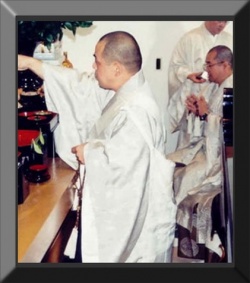Thirty More Tassel Strand Beads - Signify three thousand realms in a single moment of life
by
David Heimburg
On the long tassel strands there are thirty more beads remaining that have not yet been discussed. On the ends with two strands there are five beads each, and on the end with three strands there are five beads on two of them and ten beads on the remaining one.
(These beads are far easier to observe than explain their location.)
This is a complex philosophical system established by T'ien-t'ai (538-597) of China.
The theory states that three thousand realms, or the entire phenomenal world, exists in a single moment of life. A "single moment of life" is also translated as one mind, one thought, or one thought-moment.
The number three thousand comes from the following calculation: 10 (ten worlds) x 10 (ten worlds - within the previous ten) x 10 (ten factors) x 3 (three realms of existence) = 3000. Life at any moment manifests one of the ten worlds.
Each of these worlds possesses the potential for all of the ten within itself, and this "mutual possession," or mutual inclusion, of the ten worlds is represented as 10 x 10 = 100 possible worlds. Each of these hundred worlds possesses the ten factors, making one thousand factors or potentials, and these operate within each of the three realms of existence, thus making three thousand realms.
The ten factors are descriptions of spiritual aspects of life or reality.
They are:
(1) Appearance: attributes of things discernible from the outside, such as color, form, shape, and behavior.
(2) Nature: the inherent disposition or quality of a thing or being that cannot be discerned from the outside. T'ien-t'ai also refers to the "true nature," which he regarded as the ultimate truth or Buddha nature.
(3) Entity: the essence of life that permeates and integrates appearance and nature. [These first three factors describe the reality of life itself.
The next six factors explain the functions and workings of life.
(4) Power: life's potential energy.
(5) Influence: the action or movement produced when life's inherent power is activated.
(6) Internal cause: the cause latent in life that produces an effect of the same quality as itself, i.e., good, evil, or neutral.
(7) Relation: the relationship of indirect causes to the internal cause. Indirect causes are various conditions, both internal and external, that help the internal cause produce an effect.
(8) Latent effect: the effect produced in life when an internal cause is activated through its relationship with various conditions.
(9) Manifest effect: the tangible, perceivable result that emerges in time as an expression of a latent effect and therefore of an internal cause, again through its relationship with various conditions. (
10) Their consistency from beginning to end: the unifying factor among the ten factors.
It indicates that all of the other nine factors from the beginning (appearance) to the end (manifest effect) are consistently and harmoniously interrelated.
All nine factors thus consistently and harmoniously express the same condition of existence at any given moment.
The three realms of existence are (1) The realm of the five components: An analysis of the nature of a living entity in terms of how it responds to its surroundings.
(2) The realm of living beings: The individual living being, formed of a temporary union of the five components, who manifests or experiences any of the ten worlds. (3) The realm of the environment:
The place or land where living beings dwell and carry out life-activities.
The state of the land is a reflection of the state of life of the people who live in it.
A land manifests any of the ten worlds according to which of the ten worlds dominate in the lives of its inhabitants.
These three realms are not to be viewed separately, but as aspects of an integrated whole, which simultaneously manifests any of the ten worlds.
A single moment of life means life as an indivisible whole that includes body and mind, cause and effect, and sentient and insentient things.
A single moment of life is endowed with the three thousand realms or possibilities within it. Nichiren advocated that by chanting Namu-Myoho-Renge-Kyo one can "see" or observe the existence of the realm of Buddhahood within their own life and within the lives of others from among any other of the possible realms.
The Jars - Signify the accumulation of benefit and the process of attaining Buddhahood
On the ends of four of the five strands you'll find tube or jar shaped beads.
These signify vessels to accumulate fortune through one's practice of chanting Namu-Myoho-Renge-Kyo.
They have a pass-through hole for the tassels to be attached, and this is indicative of the flow of Buddhahood.
Attaining Buddhahood is a process rather than a point in time.
As you chant and develop your bodhisattva practice of compassion for others, the merits of your efforts accumulate in your life.
Sometimes, you're so focused on helping others attain Buddhahood you scarcely notice your own happiness that has resulted from such efforts.
But whether you notice it or not, happiness does begin to build up from the very first moment you begin your practice of chanting meditation. But this happiness is not a static state.
It is more akin to a flowing river the current of which is determined by your efforts to practice Buddhism. Happiness, thus built up, is difficult to extinguish and is commensurate with your own efforts to give it to others.

